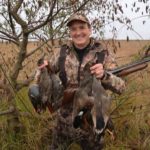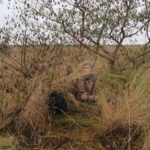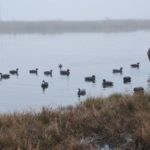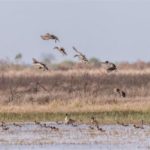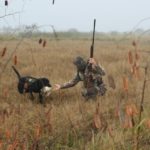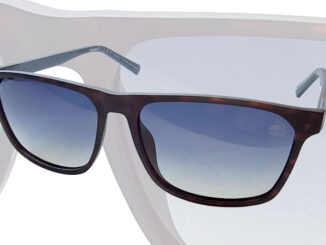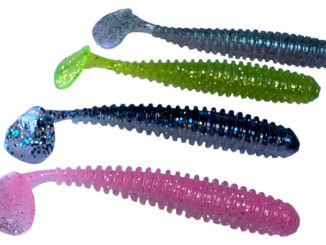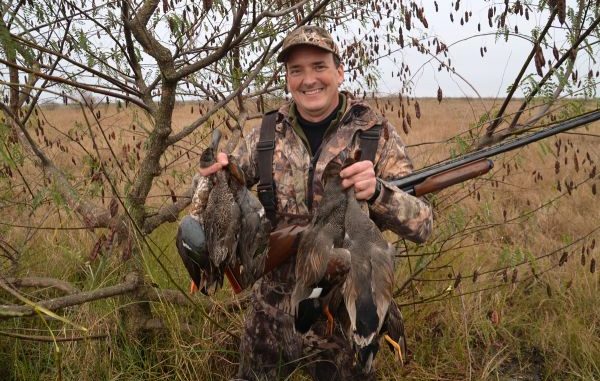
When this hunter was the LDWF’s Atchafalaya Delta Wildlife Management Area manager, he hunted every morning and evening of the duck seasons. And he still hunts the same, simple way — and kills plenty of birds. Here’s his approach.
His blind was ridiculously simple.
The hunter was perched on his shell bucket on one end of a poke boat-style pirogue pulled up on the marsh bank under a rattlebox plant.
He had no blind, at least as most duck hunters would call it — just some clumps of marsh grass pulled in front of him and on each side.
Roux, his one-year-old impressively birdy black Lab sat patiently beside him, alertly watching for whatever his master might miss.
It was a modest arrangement for one who was recently one of the Louisiana Department of Wildlife and Fisheries’ important duck people and is now a pooh-bah with Ducks Unlimited in Louisiana.
Mike Carloss’ credentials of expertise and his style of hunting were exactly why I wanted to hunt with him; I wanted to pick his brain about the future of waterfowl hunting, and at the same time enjoy how he hunts.
I first met Carloss on the Wax Delta of the Atchafalaya Delta Wildlife Management Area when he was a young biologist/refuge manager for LDWF. The energetic nimrod would squeeze in a duck hunt every morning or afternoon when he wasn’t doing refuge work or hunter law enforcement.
He was in a reflective mood this misty morning.
“In many ways, this has become a rich man’s sport,” he mused after sitting quietly for 20 minutes in the dark. “I don’t see as many people willing to rough it as I used to.”
Increasing light revealed that Carloss had set out a very unconventional decoy spread. Most of his dekes were coots or coot imitations. The faux-coots were standard mallard decoys painted black with white bills, as well as a handful of black-painted 2-liter soft drink bottles thrown in for good measure.
The coots were set to the right and front. A few wigeon, gray duck and pintail decoys were set near the cluster of coots.
To the left front were four token mallard blocks and a dozen green-winged teal dekes. A wide gap was left open between these duck and the coot decoys.
“I always leave a landing zone in the middle of the spread,” Carloss explained. “I’ve noticed that gadwalls tend to land by themselves. The gap gives them plenty of room to do that. Gadwalls get tough later in the season; they want big ponds, and they like to land in the middle of them.
“I don’t see a lot of mallards here, so I don’t use (those decoys).”
And then he chuckled.
“Maybe I’m overthinking this,” he said “After all, I use coke bottles.”
This hunt was late in the season, but the gadwalls that flew by his setup on this misty, calm morning displayed little of the wariness for which they are so well known.
Besides his decoy spread, some of the bird’s comfort was probably due to his calling and some of it his selection of hunting site.
“Gadwalls are not very vocal,” he said.
He blew his Duck Commander gadwall call intermittently rather than often, using short nasally quacks — “enkh, enkh.”
The calling was soft and subdued.
“I tend to call differently in different habitats,” Carloss explained. “It’s based on what I see and hear in each place.”
His choice of where to set up blended perfectly into the landscape. He snuggled under a stout rattlebox plant. The vegetation was sparse enough to easily see through to spot and track ducks.
“I like tall vegetation behind me,” he explained. “It’s great cover; it’s natural and it breaks my outline.
The sides of the “blind” were clumps of wiregrass that he pulled up and set around the pirogue.
“I like to be more mobile than a fixed blind allows,” Carloss continued. “That comes from my Wax Lake days. Birds move around, and I want to move with them.
“I despise big blinds sticking out in the open; birds flare off that. I’m not saying teal won’t buzz the blind, but by and large birds avoid them.”
The morning was foggy, dreary and damp. The ducks just seem to pop up out of nowhere. And they really seemed to like his coots.
Young Roux put on an impressive show that morning. Carloss knocked down two teal. One had only the end of one wing clipped and was active and vigorous; Roux took off after the cripple, which responded by flutter-jumping across the large pond.
Before the dog got to the duck, it dove. Roux kept searching, whirling around in circles to see the bird when it surfaced.
The teal came up near the bank and quickly dove into the marsh grass.
Roux caught the scent of the bird, turned on his afterburners, raced across the pond and into the wiregrass to nab it.
“I really love hunting with a dog,” Carloss cooed as the dog splashed proudly back to his master. “They are fun to watch.”
The morning went quickly. After the two teal, Carloss added a gray duck, and then two more teal, a beautiful drake gray duck, a spoonie and then a final gray, also a big drake.
“I’m not above taking them, Carloss said of the spoonie. “I love all ducks.”
